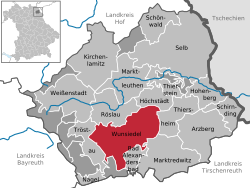Wunsiedel
| Wunsiedel | ||
|---|---|---|
|
||
| Coordinates: 50°1′N 12°1′E / 50.017°N 12.017°ECoordinates: 50°1′N 12°1′E / 50.017°N 12.017°E | ||
| Country | Germany | |
| State | Bavaria | |
| Admin. region | Oberfranken | |
| District | Wunsiedel im Fichtelgebirge | |
| Government | ||
| • Mayor | Karl-Willi Beck (CSU) | |
| Area | ||
| • Total | 54.91 km2 (21.20 sq mi) | |
| Population (2015-12-31) | ||
| • Total | 9,203 | |
| • Density | 170/km2 (430/sq mi) | |
| Time zone | CET/CEST (UTC+1/+2) | |
| Postal codes | 95632 | |
| Dialling codes | 09232 | |
| Vehicle registration | WUN | |
| Website | www.wunsiedel.de | |
Wunsiedel is the seat of the Upper Franconian district of Wunsiedel in northeast Bavaria, Germany. The town became well known for its annual Luisenburg Festival and the Rudolf Hess Memorial March held there by the Neo-Nazis until 2005.
Wunsiedel lies in the Fichtelgebirge Mountains in the valley of the Röslau at the foot of the Kösseine Plateau.
Wunsiedel was first mentioned in 1163 as the seat of a ministerialis, Adelbertus or Albert. The name probably originates from wunne = glades and sedel = noble seat. In 1285, Burgrave Friedrich III of Nürnberg received the fiefdom of the town from King Rudolph I of Habsburg. In 1326, Wunsiedel was given town rights by Burgrave Friedrich IV and this was confirmed in 1328 by Emperor Louis the Bavarian. In 1430 Hans of Kotzau defeated the Hussites in the Battle of Katharinenberg, a low mountain immediately south of Wunsiedel, and in 1652 Jobst of Schirnding beat the Bohemians also on the Katharinenberg.
In the Middle Ages, Wunsiedel was a centre of tin mining and achieved great economic importance through the manufacture of tin plate. In 1613, it became capital of the Sechsämterland – an area comparable in size to the modern district Wunsiedel im Fichtelgebirge. The bailiffs (Amtmänner) in Hohenberg, Weißenstadt, Kirchenlamitz, Selb and Thierstein were all subordinated to the high bailiff (Amtshauptmann) in Wunsiedel.
...
Wikipedia



